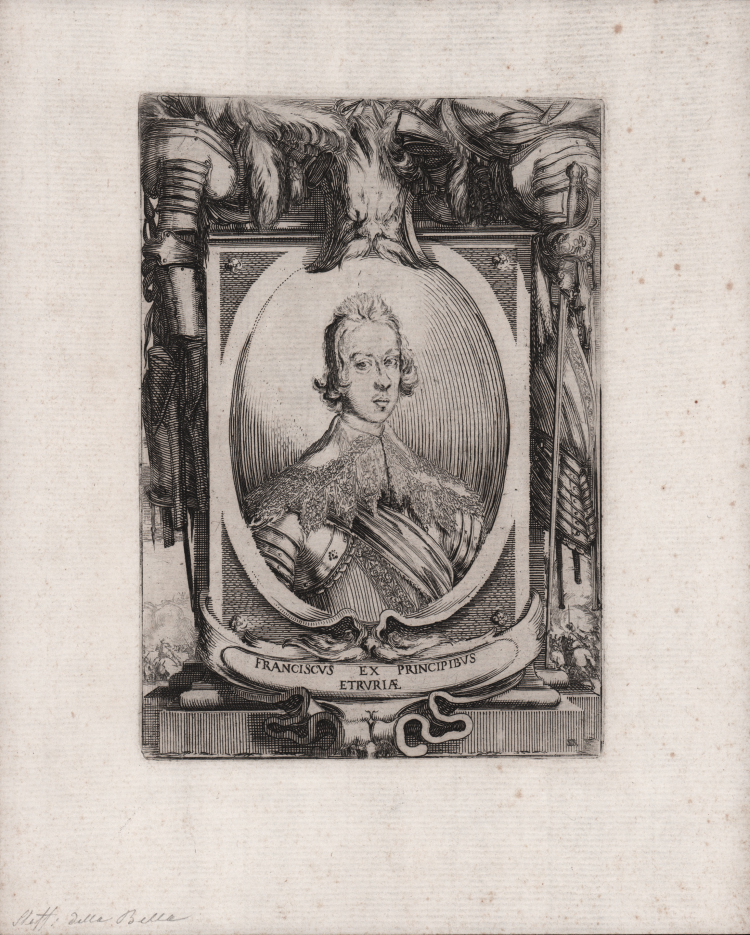




| Reference: | S42104 |
| Author | Stefano Della BELLA |
| Year: | 1634 ca. |
| Measures: | 120 x 172 mm |



| Reference: | S42104 |
| Author | Stefano Della BELLA |
| Year: | 1634 ca. |
| Measures: | 120 x 172 mm |
Etching, 1634 circa, signed at the bottom on the right with bound monogram SDB; latin inscription in the cartouche FRANCISCUS EX PRINCIPIBUS / ETRURIAE.
Magnificent example, printed on contemporary laid paper, wide margins, in excellent condition.
Portrait in oval of Francesco de’ Medici (16 October 1614 – 25 July 1634), son of Cosimo II, at his age of 19, bust ¾ to the right, flanked by arms. He was the fourth son of Grand Duke Cosimo II of Tuscany and his wife, Maria Maddalena of Austria. He died, unmarried, from plague during the Siege of Ratisbon, 1634.
The portrait by Della Bella must have been made posthumously for Francesco's funeral book, published in 1634 Esequie del Serenissimo Principe Francesco celebrate in Fiorenza…il dì 30 d’agosto 1634, descritte da Andrea Cavalcanti (Landini, 1634) . Its probable source is the portrait of Francesco by Justus Susterman in the Royal Apartments at the Pitti Palace. The head and features appear to be the same, though reversed in the etching. The armor, lace collar, and scarf are similar. Della Bella shows Francesco hatless, and presumably with his own hair, rather than in the wig of the painted portrait.
Stefano della Bella was one of the most interesting and original engravers in 17th-century Florence and can be considered the only brilliant continuator of Jacques Callot's work. His artistic education began in Florence in the workshop of the goldsmiths Gasparo Mola and Orazio Vanni, and the precision of sign, typical of the goldsmith's art, will remain characteristic of his style. He then studied under Giovanni Battista Vanni and perhaps also under Cantagallina and Cesare Dandini, but soon turned to engraving. His real master can be considered Jacques Callot, the French engraver who stayed in Florence for a long time and left a strong imprint on the city's artistic scene.
The most important years of his career were the ones he spent in Paris, from 1639 to 1650, salaried by Lorenzo de' Medici: he worked together with Israel Silvestre, with the publishers Langlois, Ciartres and Pierre Mariette, for French printers and for commissions of great prestige, such as those of 1641 for Cardinal Richelieu, who entrusted him with illustrations of his warlike exploits.
Around 1647, during a trip to Holland, where he executed etchings with views of the port of Amsterdam, he met Rembrandt, and from that date we note a profound echo of the Dutchman's art in Della Bella's graphic work.
Bibliografia
De Vesme – Massar, n. 36, p. 54; J. Talbierska, Stefano della Bella: Etchings from the Collection of the Print Room of the Warsaw University Library. Warsaw, 2001, cat. n. 10, p. 43.
Stefano Della BELLA (Firenze 1610 - 1664)
|
Stefano della Bella was one of the most interesting and ingenious artists of XVII century in Florence and can be considered as the sole real follower of Callot. He was educated in Florence at first, in the studio of Gasparo Mola and Orazio Vanni; this experience gave him a firm and careful hand when using the graver. He then went to Giovan Battista Vanni’s and, very likely, he also studied with Cantagallina and Cesare Dandini but, as Baldinucci said, he was still very young when he decided to leave painting and devoute entirely himself to engraving. His real master, then, can be considered Jacques Callot, the French engraver who lived for long time in Florence spreading his influence all around the city.
Lorenzo dè Medici became soon Stefano’s patron and invited the young artist in Rome between 1633 and 1636; in the Eternal City, the artist realized many copies from the antiquities and from Polidoro’s works. In 1633 he realized his first noteworthy work: Entrata a Roma dell’ambasciatore di Polonia Giorgio Ossolinsky.
In 1639 Stefano went to Paris where he lived, until 1650, out of a pension Lorenzo dè Medici had granted to him.
Around 1647, when travelling along the Netherlands, he met Rembrandt; from that moment the influence of the Dutch artist can be found in the entire Della Bella’s production.
|
Stefano Della BELLA (Firenze 1610 - 1664)
|
Stefano della Bella was one of the most interesting and ingenious artists of XVII century in Florence and can be considered as the sole real follower of Callot. He was educated in Florence at first, in the studio of Gasparo Mola and Orazio Vanni; this experience gave him a firm and careful hand when using the graver. He then went to Giovan Battista Vanni’s and, very likely, he also studied with Cantagallina and Cesare Dandini but, as Baldinucci said, he was still very young when he decided to leave painting and devoute entirely himself to engraving. His real master, then, can be considered Jacques Callot, the French engraver who lived for long time in Florence spreading his influence all around the city.
Lorenzo dè Medici became soon Stefano’s patron and invited the young artist in Rome between 1633 and 1636; in the Eternal City, the artist realized many copies from the antiquities and from Polidoro’s works. In 1633 he realized his first noteworthy work: Entrata a Roma dell’ambasciatore di Polonia Giorgio Ossolinsky.
In 1639 Stefano went to Paris where he lived, until 1650, out of a pension Lorenzo dè Medici had granted to him.
Around 1647, when travelling along the Netherlands, he met Rembrandt; from that moment the influence of the Dutch artist can be found in the entire Della Bella’s production.
|